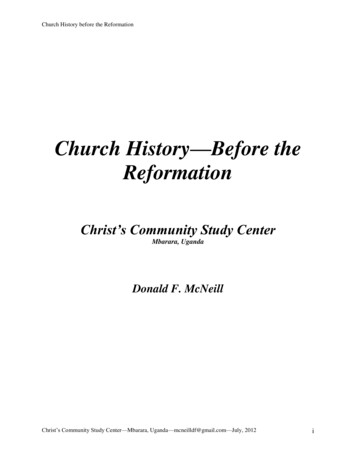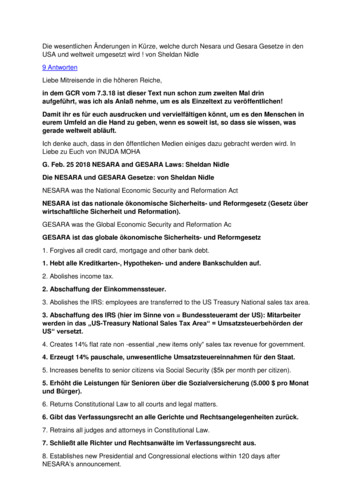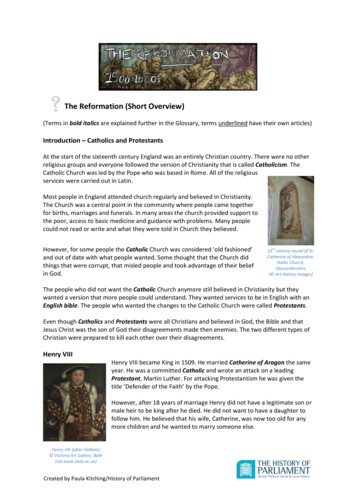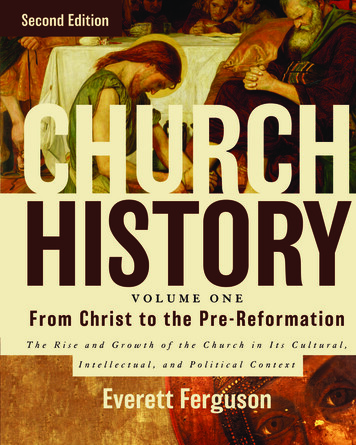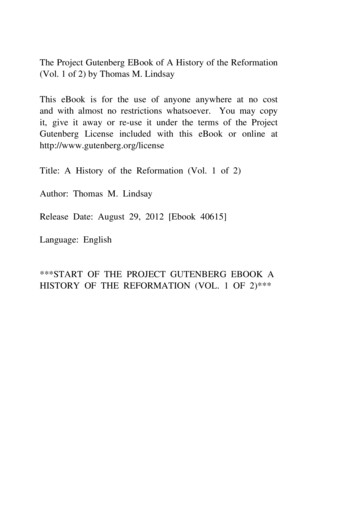
Transcription
The Project Gutenberg EBook of A History of the Reformation(Vol. 1 of 2) by Thomas M. LindsayThis eBook is for the use of anyone anywhere at no costand with almost no restrictions whatsoever. You may copyit, give it away or re-use it under the terms of the ProjectGutenberg License included with this eBook or online athttp://www.gutenberg.org/licenseTitle: A History of the Reformation (Vol. 1 of 2)Author: Thomas M. LindsayRelease Date: August 29, 2012 [Ebook 40615]Language: English***START OF THE PROJECT GUTENBERG EBOOK AHISTORY OF THE REFORMATION (VOL. 1 OF 2)***
International Theological LibraryA History of The ReformationByThomas M. Lindsay, M.A., D.D.Principal, The United Free Church College,GlasgowIn Two VolumesVolume IThe Reformation in Germany From Its Beginningto the Religious Peace of AugsburgEdinburghT. & T. Clark1906
ContentsSeries Advertisement. . . . . . . . . . . . . . . . . . . .Dedication. . . . . . . . . . . . . . . . . . . . . . . . .Preface. . . . . . . . . . . . . . . . . . . . . . . . . . .Book I. On The Eve Of The Reformation. . . . . . . . .Chapter I. The Papacy. . . . . . . . . . . . . . . . .§ 1. Claim to Universal Supremacy. . . . . . .§ 2. The Temporal Supremacy. . . . . . . . . .§ 3. The Spiritual Supremacy. . . . . . . . . .Chapter II. The Political Situation. . . . . . . . . . .§ 1. The small extent of Christendom. . . . . .§ 2. Consolidation. . . . . . . . . . . . . . . .§ 3. England. . . . . . . . . . . . . . . . . . .§ 4. France. . . . . . . . . . . . . . . . . . . .§ 5. Spain. . . . . . . . . . . . . . . . . . . . .§ 6. Germany and Italy. . . . . . . . . . . . . .§ 7. Italy. . . . . . . . . . . . . . . . . . . . .§ 8. Germany. . . . . . . . . . . . . . . . . . .Chapter III. The Renaissance. . . . . . . . . . . . . .§ 1. The Transition from the Mediæval to theModern World. . . . . . . . . . . . . .§ 2. The Revival of Literature and Art. . . . . .§ 3. Its earlier relation to Christianity. . . . . .§ 4. The Brethren of the Common Lot. . . . . .§ 5. German Universities, Schools, and Scholarship. . . . . . . . . . . . . . . . . . . .§ 6. The earlier German Humanists. . . . . . .§ 7. The Humanist Circles in the Cities. . . . .§ 8. Humanism in the Universities. . . . . . . .§ 9. Reuchlin. . . . . . . . . . . . . . . . . . 7479
ivA History of the Reformation (Vol. 1 of 2)§ 10. The “Epistolæ Obscurorum Virorum.” . . .§ 11. Ulrich von Hutten. . . . . . . . . . . . . .Chapter IV. Social Conditions. . . . . . . . . . . . . .§ 1. Towns and Trade. . . . . . . . . . . . . . .§ 2. Geographical Discoveries and the beginningof a World Trade. . . . . . . . . . . . . .§ 3. Increase in Wealth and luxurious Living. . .§ 4. The Condition of the Peasantry. . . . . . . .§ 5. Earlier Social Revolts. . . . . . . . . . . . .§ 6. The religious Socialism of Hans Böhm. . . .§ 7. Bundschuh Revolts. . . . . . . . . . . . . .§ 8. The Causes of the continuous Revolts. . . . .Chapter V. Family And Popular Religious Life in theDecades Before the Reformation. . . . . . . . . .§ 1. Devotion of Germany to the Roman Church.§ 2. Preaching. . . . . . . . . . . . . . . . . . .§ 3. Church Festivals. . . . . . . . . . . . . . . .§ 4. The Family Religious Life. . . . . . . . . . .§ 5. A superstitious Religion based on Fear. . . .§ 6. A non-Ecclesiastical Religion. . . . . . . . .§ 7. The “Brethren.” . . . . . . . . . . . . . . . .Chapter VI. Humanism And Reformation. . . . . . . .§ 1. Savonarola. . . . . . . . . . . . . . . . . . .§ 2. John Colet. . . . . . . . . . . . . . . . . . .§ 3. Erasmus. . . . . . . . . . . . . . . . . . . .Book II. The Reformation. . . . . . . . . . . . . . . . . .Chapter I. Luther to the Beginning of the ControversyAbout Indulgences. . . . . . . . . . . . . . . . .§ 1. Why Luther was successful as the Leader ina Reformation. . . . . . . . . . . . . . .§ 2. Luther's Youth and Education. . . . . . . . .§ 3. Luther in the Erfurt Convent. . . . . . . . . .§ 4. Luther's early Life in Wittenberg. . . . . . .§ 5. Luther's early Lectures in Theology. . . . . 67173173179187206206208211217223226
v§ 6. The Indulgence-seller. . . . . . . . . . . . .Chapter II. From The Beginning of the IndulgenceControversy to the Diet of Worms. . . . . . . . .§ 1. The Theory and Practice of Indulgences inthe Sixteenth Century. . . . . . . . . . .§ 2. Luther's Theses. . . . . . . . . . . . . . . .§ 3. The Leipzig Disputation. . . . . . . . . . . .§ 4. The Three Treatises. . . . . . . . . . . . . .§ 5. The Papal Bull. . . . . . . . . . . . . . . . .§ 6. Luther the Representative of Germany. . . .Chapter III. The Diet Of Worms. . . . . . . . . . . . .§ 1. The Roman Nuncio Aleander. . . . . . . . .§ 2. The Emperor Charles V. . . . . . . . . . . .§ 3. In the City of Worms. . . . . . . . . . . . .§ 4. Luther in Worms. . . . . . . . . . . . . . . .§ 5. Luther's first Appearance before the Diet ofWorms. . . . . . . . . . . . . . . . . . .§ 6. Luther's Second Appearance before the Diet.§ 7. The Conferences. . . . . . . . . . . . . . . .§ 8. The Ban. . . . . . . . . . . . . . . . . . . .§ 9. Popular Literature. . . . . . . . . . . . . . .§ 10. The Spread of Luther's Teaching. . . . . . .§ 11. Andrew Bodenstein of Carlstadt. . . . . . .§ 12. Luther back in Wittenberg. . . . . . . . . .Chapter IV. From The Diet of Worms to the Close Ofthe Peasants' War. . . . . . . . . . . . . . . . . .§ 1. The continued spread of Lutheran Teaching.§ 2. The beginnings of Division in Germany. . .§ 3. The Peasants' War. . . . . . . . . . . . . . .§ 4. The Twelve Articles. . . . . . . . . . . . . .§ 5. The Suppression of the Revolt. . . . . . . . .§ 6. Luther and the Peasants' War. . . . . . . . .§ 7. Germany divided into two separate Camps. 20323329335340343343348350355358360362
viA History of the Reformation (Vol. 1 of 2)Chapter V. From The Diet Of Speyer, 1526, To TheReligious Peace Of Augsburg, 1555. . . . . . .§ 1. The Diet of Speyer, 1526. . . . . . . . . .§ 2. The Protest. . . . . . . . . . . . . . . . . .§ 3. Luther and Zwingli. . . . . . . . . . . . .§ 4. The Marburg Colloquy. . . . . . . . . . .§ 5. The Emperor in Germany. . . . . . . . . .§ 6. The Diet of Augsburg 1530. . . . . . . . .§ 7. The Augsburg Confession. . . . . . . . . .§ 8. The Reformation to be crushed. . . . . . .§ 9. The Schmalkald League. . . . . . . . . . .§ 10. The Bigamy of Philip of Hesse. . . . . . .§ 11. Maurice of Saxony. . . . . . . . . . . . .§ 12. Luther's Death. . . . . . . . . . . . . . .§ 13. The Religious War. . . . . . . . . . . . .§ 14. The Augsburg Interim. . . . . . . . . . .§ 15. Religious Peace of Augsburg. . . . . . . .Chapter VI. The Organisation Of Lutheran Churches.Chapter VII. The Lutheran Reformation Outside Germany. . . . . . . . . . . . . . . . . . . . . . .Chapter VIII. The Religious Principles Inspiring TheReformation. . . . . . . . . . . . . . . . . . .§ 1. The Reformation did not take its rise from aCriticism of Doctrines. . . . . . . . . .§ 2. The universal Priesthood of Believers. . . .§ 3. Justification by Faith. . . . . . . . . . . . .§ 4. Holy Scripture. . . . . . . . . . . . . . . .§ 5. The Person of Christ. . . . . . . . . . . . .§ 6. The Church. . . . . . . . . . . . . . . . .Index. . . . . . . . . . . . . . . . . . . . . . . . . . . .Footnotes . . . . . . . . . . . . . . . . . . . . . . . . 27. 444. 453.453462472481496509518583
[Transcriber's Note: The cover image was produced by thesubmitter at Distributed Proofreading, and is being placed intothe public domain.][i]
Series Advertisement.The International Theological Library.UNDER THE EDITORSHIP OFTHE REV. CHARLES A. BRIGGS, D.D., D.LIT.,Professor of Theological Encyclopædia and Symbolics, UnionTheological Seminary, New York;ANDTHE LATE REV. STEWART D. F. SALMOND, D.D.,Principal, and Professor of Systematic Theology and NewTestament Exegesis, United Free Church College, Aberdeen.This Library is designed to cover the whole field of ChristianTheology. Each volume is to be complete in itself, while, atthe same time, it will form part of a carefully planned whole.It is intended to form a Series of Text-Books for Students ofTheology. The Authors will be scholars of recognised reputationin the several branches of study assigned to them. They will beassociated with each other and with the Editors in the effort toprovide a series of volumes which may adequately represent thepresent condition of investigation.THIRTEEN VOLUMES OF THE SERIES ARE NOW READY, VIZ.:—An Introduction to the Literature of the Old Testament. ByS. R. DRIVER, D.D., D.Litt., Regius Professor of Hebrew, andCanon of Christ Church, Oxford. Seventh Edition. 12s.Christian Ethics. By NEWMAN SMYTH, D.D., Pastor of the FirstCongregational Church, New Haven, Conn. Third Edition. 10s.6d.
Series Advertisement.3Apologetics. By the late A. B. BRUCE, D.D., Professor ofNew Testament Exegesis, Free Church College, Glasgow. ThirdEdition. 10s. 6d.History of Christian Doctrine. By G. P. FISHER, D.D., LL.D.,Professor of Ecclesiastical History, Yale University, New Haven,Conn. Second Edition. 12s.A History of Christianity In the Apostolic Age. By ARTHURCUSHMAN MCGIFFERT, Ph.D., D.D., Professor of Church History,Union Theological Seminary, New York. 12s.Christian Institutions. By A. V. G. ALLEN, D.D., Professorof Ecclesiastical History, Episcopal Theological School,Cambridge, Mass. 12s.The Christian Pastor. By WASHINGTON GLADDEN, D.D., LL.D.,Pastor of Congregational Church, Columbus, Ohio. 10s. 6d.The Theology of the New Testament. By GEORGE B.STEVENS, D.D., LL.D., Professor of Systematic Theology inYale University, U.S.A. 12s.The Ancient Catholic Church. By ROBERT RAINY, D.D.,Principal of The New College, Edinburgh. 12s.Old Testament History. By H.P. SMITH, D.D., Professor ofBiblical History, Amherst College, U.S.A. 12s.The Theology of the Old Testament. By the late A.B.DAVIDSON, D.D., LL.D. Edited by the late Principal SALMOND,D.D. 12s.Doctrine of Salvation. By GEORGE B. STEVENS, D.D., LL.D.,Professor of Systematic Theology, Yale University. 12s.The Reformation. (Vol. I.—In Germany.) By T. M. LINDSAY,D.D., Principal of the United Free Church College, Glasgow.10s. 6d.VOLUMES IN PREPARATION:—The Reformation. (Vol. II.—In Lands beyond Germany.)By T.M. LINDSAY, D.D., Principal of the United Free ChurchCollege, Glasgow.[ii]
4A History of the Reformation (Vol. 1 of 2)The Literature of the New Testament. By JAMES MOFFATT,D.D., United Free Church, Dundonald, Scotland.Contemporary History of the Old Testament. By FRANCISBROWN, D.D., D.Lit., Professor of Hebrew and CognateLanguages, Union Theological Seminary, New York.The Early Latin Church. By CHARLES BIGG, D.D., RegiusProfessor of Church History, and Canon of Christ Church,Oxford.Canon and Text of the New Testament. By CASPAR RENÉGREGORY, D.D., LL.D., Professor in the University of Leipzig.Contemporary History of the New Testament. By FRANK C.PORTER, Ph.D., Yale University, New Haven, Conn.Philosophy of Religion. By ROBERT FLINT, D.D., LL.D.,Emeritus Professor of Divinity, University of Edinburgh.Later Latin Church. By E. W. WATSON, M.A., Professor ofChurch History, King's College, London.The Christian Preacher. By W. T. DAVISON, D.D., Tutor inSystematic Theology, Richmond College, Surrey.The Greek and Oriental Churches. By W. F. ADENEY, D.D.,Principal of Lancashire College, Manchester.Biblical Archæology. By G. BUCHANAN GRAY, D.D., Professorof Hebrew, Mansfield College, Oxford.The History of Religions. By GEORGE F. MOORE, D.D., LL.D.,Professor in Harvard University.Doctrine of God. By WILLIAM N. CLARKE, D.D. Professor ofSystematic Theology, Hamilton Theological Seminary, N.Y.Doctrine of Christ. By H.R. MACKINTOSH, Ph.D., Professor ofSystematic Theology, The New College, Edinburgh.Doctrine of Man. By WILLIAM P. PATERSON, D.D., Professorof Divinity, University of Edinburgh.Canon and Text of the Old Testament. By F.C. BURKITT, M.A.,University Lecturer on Pal ography, Trinity College, Cambridge.
Series Advertisement.5The Life of Christ. By WILLIAM SANDAY, D.D., LL.D., LadyMargaret Professor of Divinity, and Canon of Christ Church,Oxford.Christian Symbolics. By C. A. BRIGGS, D.D., D.Lit., Professorof Theological Encyclopedia and Symbolics, Union TheologicalSeminary, New York.Rabbinical Literature. By S. SCHECHTER, M.A., President ofthe Jewish Theological Seminary, N.Y.[vi]
Dedication.TOTHE REV. GEORGE CLARK HUTTON, D.D.[vii]
Preface.This History of the Reformation has been written with theintention of describing a great religious movement amid itssocial environment. The times were heroic, and producedgreat men, with striking individualities not easily weighed inmodern balances. The age is sufficiently remote to compel us toremember that while the morality of one century can be judgedby another, the men who belong to it must be judged by thestandard of their contemporaries, and not altogether by ours. Thereligious revival was set in a framework of political, intellectual,and economic changes, and cannot be disentangled from itssurroundings without danger of mutilation. All these things addto the difficulty of description.My excuse, if excuse be needed, for venturing on the task isthat the period is one to which I have devoted special attention formany years, and that I have read and re-read most of the originalcontemporary sources of information. While full use has beenmade of the labours of predecessors in the same field, no chapterin the volume, save that on the political condition of Europe,has been written without constant reference to contemporaryevidence.A History of the Reformation, it appears to me, mustdescribe five distinct but related things—the social and religiousconditions of the age out of which the great movement came; theLutheran Reformation down to 1555, when it received legalrecognition; the Reformation in countries beyond Germanywhich did not submit to the guidance of Luther; the issue ofcertain portions of the religious life of the Middle Ages inAnabaptism, Socinianism, and Anti-Trinitarianism; and, finally,the Counter-Reformation.[viii]
8[ix]A History of the Reformation (Vol. 1 of 2)The second follows the first in natural succession; but the thirdwas almost contemporary with the second. If the Reformationwon its way to legal recognition earlier in Germany than inany other land, its beginnings in France, England, and perhapsthe Netherlands, had appeared before Luther had published hisTheses. I have not found it possible to describe all the five inchronological order.This volume describes the eve of the Reformation and themovement itself under the guidance of Luther. In a secondvolume I hope to deal with the Reformation beyond Germany,with Anabaptism, Socinianism, and kindred matters which hadtheir roots far back in the Middle Ages, and with the CounterReformation.The first part of this volume deals with the intellectual, social,and religious life of the age which gave birth to the Reformation.The intellectual life of the times has been frequently described,and its economic conditions are beginning to attract attention.But few have cared to investigate popular and family religiouslife in the decades before the great revival. Yet for the historyof the Reformation movement nothing can be more important.When it is studied, it can be seen that the evangelical revivalwas not a unique phenomenon, entirely unconnected with theimmediate past. There was a continuity in the religious lifeof the period. The same hymns were sung in public and inprivate after the Reformation which had been in use beforeLuther raised the standard of revolt. Many of the prayers inthe Reformation liturgies came from the service-books of themediæval Church. Much of the family instruction in religiousmatters received by the Reformers when they were children wasin turn taught by them to the succeeding generation. The greatReformation had its roots in the simple evangelical piety whichhad never entirely disappeared in the mediæval Church. Luther'steaching was recognised by thousands to be no startling novelty,but something which they had always at heart believed, though
Preface.9they might not have been able to formulate it. It is true thatLuther and his fellow-Reformers taught their generation that OurLord, Jesus Christ, filled the whole sphere of God, and that othermediators and intercessors were superfluous, and that they alsodelivered it from the fear of a priestly caste; but men did notreceive that teaching as entirely new; they rather accepted it assomething they had always felt, though they had not been ableto give their feelings due and complete expression. It is true thatthis simple piety had been set in a framework of superstition, andthat the Church had been generally looked upon as an institutionwithin which priests exercised a secret science of redemptionthrough their power over the sacraments; but the old evangelicalpiety existed, and its traces can be found when sought for.A portion of the chapter which describes the family and popularreligious life immediately preceding the Reformation has alreadyappeared in the London Quarterly Review for October 1903.In describing the beginnings of the Lutheran Reformation, Ihave had to go over the same ground covered by my chapteron “Luther” contributed to the second volume of the CambridgeModern History, and have found it impossible not to repeatmyself. This is specially the case with the account given ofthe theory and practice of Indulgences. It ought to be said,however, that in view of certain strictures on the earlier work byRoman Catholic reviewers, I have gone over again the statementsmade about Indulgences by the great mediæval theologians ofthe thirteenth and fifteenth centuries, and have not been able tochange the opinions previously expressed.My thanks are due to my colleague, Dr. Denney, and to anotherfriend for the care they have taken in revising the proof-sheets,and for many valuable suggestions which have been given effectto.Thomas M. Lindsay.March, 1906.[x]
10[001]A History of the Reformation (Vol. 1 of 2)
Book I. On The Eve Of TheReformation.Chapter I. The Papacy.1 xix.§ 1. Claim to Universal Supremacy.1SOURCES:{FNS Apparatus super quinque libris decretalium (Strassburg,1488); Burchard, Diarium (ed. by Thuasne, Paris, 1883-1885), in 3vols.; Brand, Narrenschiff (ed. by Simrock, Berlin, 1872); Denzinger,Enchiridion Symbolorum et Definitionum, quæ de rebus fidei et morum aconciliis æcumenicis et summis pontificibus, emanarunt (Würzburg, 1900),9th ed.; Erler, Der Liber Cancellariæ Apostolicæ vom Jahre 1480 (Leipzig,1888); Faber, Tractatus de Ruine Ecclesie Planctu (Memmingen); Murner,Schelmenzunft and Narrenbeschwörung (Nos. 85, 119-124 of Neudruckedeutschen Litteraturwerke); Mirbt, Quellen zur Geschichte des Papsttums(Freiburg i. B. 1895); Tangl, Die päpstlichen Kanzleiordnungen von 12001500 (Innsbruck, 1894); and Das Taxwesen der päpstlichen Kirche (Mitt. desInstituts für österreichische Geschichtsforschung, xiii. 1892).LATER BOOKS:{FNS “Janus,” The Pope and the Council (London, 1869);Harnack, History of Dogma (London, 1899), vols. vi. vii.; Thudichen,Papsitum und Reformation (Leipzig, 1903); Haller, Papsitum und KirchenReform (1903); Lea, Cambridge Modern History (Cambridge, 1902), vol.I.{FNS
12A History of the Reformation (Vol. 1 of 2)The long struggle between the Mediæval Church and the Mediæval Empire, between the priest and the warrior,2 ended, in theearlier half of the thirteenth century, in the overthrow of theHohenstaufens, and left the Papacy sole inheritor of the claim ofancient Rome to be sovereign of the civilised world.Roma caput mundi regit orbis frena rotundi.[002]Strong and masterful Popes had for centuries insisted onexercising powers which, they asserted, belonged to them as thesuccessors of St. Peter and the representatives of Christ uponearth. Ecclesiastical jurists had translated their assertions intolegal language, and had expressed them in principles borrowedfrom the old imperial law. Precedents, needed by the legal mindto unite the past with the present, had been found in a series ofimaginary papal judgments extending over past centuries. Theforged decretals of the pseudo-Isidor (used by Pope Nicholas I.in his letter of 866 A.D. to the bishops of Gaul), of the groupof canonists who supported the pretensions of Pope Gregory VII.(1073-1085),—Anselm of Lucca, Deusdedit, Cardinal Bonzio,and Gregory of Pavia,—gave to the papal claims the semblanceof the sanction of antiquity. The Decretum of Gratian, issuedin 1150 from Bologna, then the most famous Law School inEurope, incorporated all these earlier forgeries and added newones. It displaced the older collections of Canon Law and becamethe starting-point for succeeding canonists. Its mosaic of factsand falsehoods formed the basis for the theories of the imperialpowers and of the universal jurisdiction of the Bishops of Rome.32“In hac (sc. ecclesia) ejusque potestate duos esse gladios, spiritualemvidelicet et temporalem, evangelicis dictis instruimur. Ille sacerdotis, ismanu regum et militum, sed ad nutum et patienciam sacerdotis”; BonifaceVIII.{FNS in the Bull, Unam Sanctam.3A succinct account of these forgeries will be found in “Janus,” The Popeand the Council (London, 1869), p. 94.
§ 1. Claim to Universal Supremacy.13The picturesque religious background of this conception of theChurch of Christ as a great temporal empire had been furnished bySt. Augustine, although probably he would have been the first toprotest against the use made of his vision of the City of God. Hisunfinished masterpiece, De Civitate Dei, in which with a devoutand glowing imagination he had contrasted the Civitas Terrena,or the secular State founded on conquest and maintained by fraudand violence, with the Kingdom of God, which he identified withthe visible ecclesiastical society, had filled the imagination ofall Christians in the days immediately preceding the dissolutionof the Roman Empire of the West, and had contributed in aremarkable degree to the final overthrow of the last remainsof a cultured paganism. It became the sketch outline which thejurists of the Roman Curia gradually filled in with details by theirstrictly defined and legally expressed claim of the Roman Pontiffto a universal jurisdiction. Its living but poetically indefiniteideas were transformed into clearly defined legal principlesfound ready-made in the all-embracing jurisprudence of theancient empire, and were analysed and exhibited in definiteclaims to rule and to judge in every department of humanactivity. When poetic thoughts, which from their very naturestretch forward towards and melt in the infinite, are imprisonedwithin legal formulas and are changed into principles of practicaljurisprudence, they lose all their distinctive character, and thecreation which embodies them becomes very different from whatit was meant to be. The mischievous activity of the Romancanonists actually transformed the Civitas Dei of the gloriousvision of St. Augustine into that Civitas Terrena which hereprobated, and the ideal Kingdom of God became a vulgarearthly monarchy, with all the accompaniments of conquest,fraud, and violence which, according to the great theologianof the West, naturally belonged to such a society. But theglamour of the City of God long remained to dazzle the eyesof gifted and pious men during the earlier Middle Ages, when[003]
14A History of the Reformation (Vol. 1 of 2)they contemplated the visible ecclesiastical empire ruled by theBishop of Rome.[004]The requirements of the practical religion of everyday lifewere also believed to be in the possession of this ecclesiasticalmonarchy to give and to withhold. For it was the almostuniversal belief of mediæval piety that the mediation of a priestwas essential to salvation; and the priesthood was an integralpart of this monarchy, and did not exist outside its boundaries.“No good Catholic Christian doubted that in spiritual things theclergy were the divinely appointed superiors of the laity, that thispower proceeded from the right of the priests to celebrate thesacraments, that the Pope was the real possessor of this power,and was far superior to all secular authority.”4 In the decadesimmediately preceding the Reformation, many an educated manmight have doubts about this power of the clergy over thespiritual and eternal welfare of men and women; but when itcame to the point, almost no one could venture to say that therewas nothing in it. And so long as the feeling remained thatthere might be something in it, the anxieties, to say the least,which Christian men and women could not help having whenthey looked forward to an unknown future, made kings andpeoples hesitate before they offered defiance to the Pope andthe clergy. The spiritual powers which were believed to comefrom the exclusive possession of priesthood and sacraments wentfor much in increasing the authority of the papal empire and inbinding it together in one compact whole.In the earlier Middle Ages the claims of the Papacy to universalsupremacy had been urged and defended by ecclesiastical juristsalone; but in the thirteenth century theology also began to statethem from its own point of view. Thomas Aquinas set himselfto prove that submission to the Roman Pontiff was necessary forevery human being. He declared that, under the law of the New4Harnack, History of Dogma, vi. 132 n. (Eng. trans.).
§ 1. Claim to Universal Supremacy.15Testament, the king must be subject to the priest to the extentthat, if kings proved to be heretics or schismatics, the Bishopof Rome was entitled to deprive them of all kingly authority byreleasing subjects from their ordinary obedience.5The fullest expression of this temporal and spiritual supremacyclaimed by the Bishops of Rome is to be found in Pope InnocentIV.'s Commentary on the Decretals6 (1243-1254), and in the Bull,Unam Sanctam, published by Pope Boniface VIII. in 1302. Butsucceeding Bishops of Rome in no way abated their pretensionsto universal sovereignty. The same claims were made during theExile at Avignon and in the days of the Great Schism. Theywere asserted by Pope Pius II. in his Bull, Execrabilis et pristinis(1459), and by Pope Leo X. on the very eve of the Reformation,in his Bull, Pastor Æternus (1516); while Pope Alexander VI.(Rodrigo Borgia), acting as the lord of the universe, made overthe New World to Isabella of Castile and to Ferdinand of Aragonby legal deed of gift in his Bull, Inter cætera divinæ (May 4th,1493).75Compare his Opuscula contra errores Græcorum; De regimine principum.(The first two books were written by Thomas and the other two probably byTolomeo (Ptolomæus) of Lucca.)6Apparatus super quinque libris Decretalium (Strassburg, 1488).7Full quotations from the Bulls, Unam Sanctam and Inter cætera divinæ, areto be found in Mirbt's Quellen zur Geschichte des Papsttums (Leipzig, 1895),pp. 88, 107. The Bulls, Execrabilis and Pastor Æternus, are in Denzinger,Enchiridion (Würzburg, 1900), 9th ed. pp. 172, 174.The Deed of Gift of the American Continent to Isabella and Ferdinand is inthe 6th section of the Bull, Inter cætera divinæ. It is as follows:—“Motu proprio. de nostra mera liberalitate et ex certa scientia ac de apostolicæ potestatisplenitudine omnes insulas et terras firmas inventas et inveniendas, detectaset detegendas versus Occidentem et Meridiem fabricando et construendounam lineam a Polo Artico scilicet Septentrione ad Polum Antarticum scilicetMeridiem, sive terræ firmæ et insulæ inventæ et inveniendæ sint versusIndiam aut versus aliam quamcumque partem, quæ linea distet a qualibetinsularum, quæ vulgariter nuncupantur de los Azores y cabo vierde, centumleucis versus Occidentem et Meridiem; ita quod omnes insulæ et terræfirmæ, repertæ et reperiendæ, detectæ et detegendæ, a præfata linea versus[005]
16A History of the Reformation (Vol. 1 of 2)The power claimed in these documents was a twofoldsupremacy, temporal and spiritual.§ 2. The Temporal Supremacy.[006]The former, stated in its widest extent, was the right to deposekings, free their subjects from their allegiance, and bestow theirterritories on another. It could only be enforced when the Popefound a stronger potentate willing to carry out his orders, and wasnaturally but rarely exercised. Two instances, however, occurrednot long before the Reformation. George Podiebrod, the Kingof Bohemia, offended the Bishop of Rome by insisting thatthe Roman See should keep the bargain made with his Hussitesubjects at the Council of Basel. He was summoned to Rome tobe tried as a heretic by Pope Pius II. in 1464, and by Pope Paul II.in 1465, and was declared by the latter to be deposed; his subjectswere released from their allegiance, and his kingdom was offeredto Matthias Corvinus, the King of Hungary, who gladly acceptedthe offer, and a protracted and bloody war was the consequence.Later still, in 1511, Pope Julius II. excommunicated the Kingof Navarre, and empowered any neighbouring king to seize hisdominions—an offer readily accepted by Ferdinand of Aragon.8Occidentem et Meridiem per alium Regem aut Principem Christianum nonfuerint actualiter possesse usque ad diem nativitatis Domini Nostri Jesu Christiproximi præteritum . auctoritate omnipotentis Dei nobis in Beato Petroconcessa, ac vicarius Jesu Christi, qua fungimur in terris, cum omnibus illarumdominiis, civitatibus, castris, locis et villis, juribusque et jurisdictionibus acpertinentiis univeris, vobis hæredibusque et successoribus vestris in perpetuumtenore præsentium donamus. Vosque et hæredes ac successores præfatosillarum dominos cum plena, libera et omnimoda potestate, auctoritate etjurisdictione facimus, constituimus et dep
Aug 29, 2012 · The Project Gutenberg EBook of A History of the Reformation (Vol. 1 of 2) by Thomas M. Lindsay This eBook is for the use of anyone anywhere at no cost . A History of Christianity In the Apostolic Age. By ARTHUR CUSHMAN MCGIFFERT,Ph.D., D.D., Professorof
